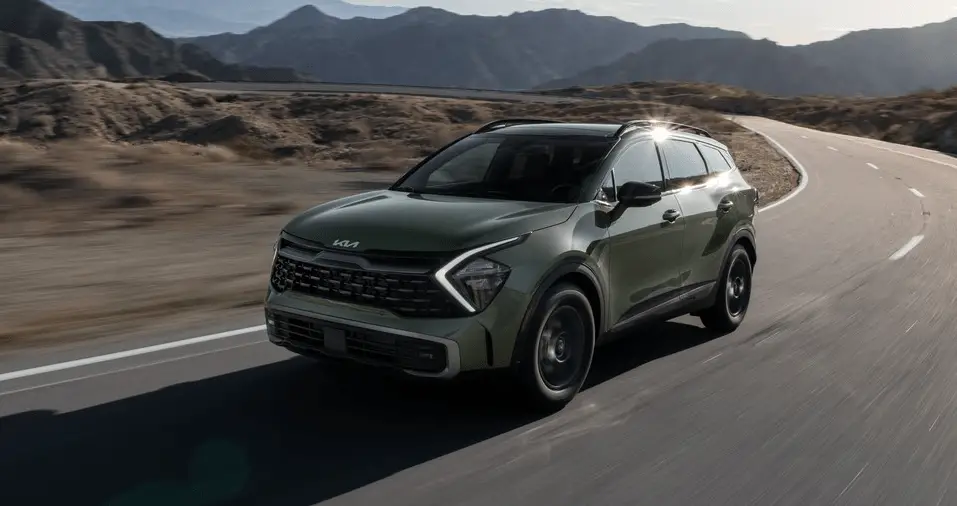Kia Sportage 2023 Introduction and Your Vehicle at a Glance
The 2023 Kia Sportage stands out as a model of modernity, usefulness, and pure driving pleasure in a world where great cars are always changing. The Hyundai Sportage is the perfect example of a modern small SUV. It has a long history of innovation and a persistent dedication to providing unbeatable value. This dynamic vehicle seamlessly blends sleek design aesthetics with practical flexibility. It comes in a variety of trim levels and powertrain choices to meet the needs and preferences of picky drivers. We’re going to take a trip through
the 2023 Kia Sportage and look at some of its most important features, including its unique design, cutting-edge technology, and the promise of an exciting driving experience inside its carefully crafted interior and cutting-edge engineering.
2023 KIA SPORTAGE Specs, Price, Features and Mileage (Brochure)
Fuel requirements
Your new vehicle is designed to use only unleaded fuel having a pump octane number ((R+M)/2) of 87 (Research Octane Number 91) or higher. (Do not use methanol blended fuels.) Your new vehicle is designed to obtain maximum performance with UNLEADED FUEL, as well as minimize exhaust emissions and spark plug fouling. Never add any fuel system cleaning agents to the fuel tank other than what has been specified. (Consult an authorized Kia dealer for details.)
Tighten the cap until it clicks one time, otherwise, the Check Engine light will appear.
WARNING
Refuelling
- Do not “top off” after the nozzle automatically shuts off. Attempts to force more fuel into the tank can cause fuel overflow onto you and the ground, causing a risk of fire.
- Always check that the fuel cap is installed securely to prevent fuel spillage, especially in the event of an accident.
Gasoline containing alcohol and methanol
Gasohol, a mixture of gasoline and ethanol (also known as grain alcohol), and gasoline or gasohol containing methanol (also known as wood alcohol) are being marketed along with or instead of leaded or unleaded gasoline. Pursuant to Environmental Protection Agency (EPA) regulations, ethanol may be used in your vehicle. Do not use gasohol containing more than 15% ethanol, and do not use gasoline or gasohol containing any methanol. Ethanol provides less energy than gasoline and attracts water. Thus, it is likely to reduce your fuel efficiency and could lower your MPG results. Methanol may cause drivability problems and damage to the fuel system, engine control system and emission control system. Discontinue using gasohol of any kind if drivability problems occur. Vehicle damage or drivability problems may not be covered by the manufacturer’s warranty if they result from the use of:
- Gasoline or gasohol containing methanol.
- Leaded fuel or leaded gasohol.
- Gasohol containing more than 15%ethanol.
“E85” fuel is an alternative fuel comprised of 85% ethanol and 15% gasoline and is manufactured exclusively for use in Flexible Fuel Vehicles. “E85” is not compatible with your vehicle. Use of
“E85” may result in poor engine performance and damage to your vehicle’s engine and fuel system. Kia recommends that customers do not use fuel with an ethanol content exceeding 15%.
NOTICE
Your New Vehicle Limited Warranty does not cover damage to the fuel system or any performance problems caused by the use of “E85” fuel.
Never use any fuel containing methanol. Discontinue the use of any methanol-containing products which may inhibit proper drivability.
2023 Kia Sportage gas Type
The 2023 Kia Sportage is primarily designed to use regular unleaded gasoline with an octane rating of 87, as specified in its owner’s manual and near the fuel filler cap. Always follow the manufacturer’s recommendations for the correct fuel type.
Other fuels
Using fuels that contain Silicone (Si), MMT (Methylcyclopentadienyl Manganese Tricarbonyl), Manganese (Mn) contained fuel, and other metallic additives may cause vehicle and engine damage or cause misfiring, poor acceleration, engine stalling, catalyst melting, clogging, abnormal corrosion, life cycle reduction, etc. Also, the Malfunction Indicator Lamp (MIL) may appear.
NOTICE
Damage to the fuel system or performance problems caused by the use of these other fuels may not be covered by your New Vehicle Limited Warranty.
Gasoline containing MMT
Some gasoline contains harmful manganese-based fuel additives Such as MMT (Methylcyclopentadienyl Manganese Tri-carbonyl). Kia does not recommend the use of gasoline containing MMT. This type of fuel can reduce vehicle performance and affect your emission control system. The Malfunction Indicator Lamp (MIL) on the cluster may come on.
Do not use methanol
Fuels containing methanol (wood alcohol) should not be used in your vehicle. This type of fuel can reduce vehicle performance and damage components of the fuel system, engine control system, and emission control system.
Fuel Additives
Kia recommends that you use good quality gasoline treated with detergent additives such as TOP TIER Detergent Gasoline, which help prevent deposit formation in the engine. These gas lines will help the engine run cleaner and enhance the performance of the emission control system.
For more information on TOP TIER Detergent Gasoline, please go to the website (www.toptiergas.com) For customers who do not use TOP TIER Deter-gent Gasoline regularly, and have problems starting or the engine does not run smoothly, additives that you can buy separately may be added to the gasoline.
If TOP TIER Detergent Gasoline is not available, one bottle of additive should be added to the fuel tank every 8,000 miles (13,000 km), or every engine oil change is recommended. Additives are available from your authorized Kia dealer along with information on how to use them. Do not mix other additives.\
Operation in foreign countries
If you are going to drive your vehicle in another country, be sure to:
- Observe all regulations regarding registration and insurance.
- Determine that acceptable fuel is available.
Vehicle modifications
This vehicle should not be modified. Modification of your vehicle could affect its performance, safety or durability and may even violate governmental safety and emissions regulations. In addition, damage or performance problems resulting from any modification may not be covered under warranty.
- If you use unauthorized electronic devices, it may cause the vehicle to operate abnormally, wire damage, battery discharge and fire. For your safety, do not use unauthorized electronic devices.
Vehicle break-in process
By following a few simple precautions for the first 600 miles (1,000 km) you may add to the performance, economy and life of your vehicle.
- Do not race the engine.
- While driving, keep your engine speed (rpm, or revolutions per minute) between 2,000 rpm and 4,000 rpm.
- Do not maintain a single engine speed for long periods of time, either fast or slow. Varying engine speeds is needed to properly break-in the engine.
- Avoid hard stops, except in emergencies, to allow the brakes to seat properly.
- Don’t tow a trailer during the first 1,200 miles (2,000 km) of operation.
- Fuel economy and engine performance may vary depending on the vehicle break-in process and be stabilized after 4,000 miles (6,000 km). New engines may consume more oil during the vehicle break-in period.
Risk of burns when parking or stopping vehicle
- Do not park or stop the vehicle near flammable items such as leaves, paper, oil, and tire. Such items placed near the exhaust system can become a fire hazard.
- When an engine idles at a high speed with the rear side of the vehicle touching the wall, heat of the exhaust gas can cause discolouration or fire. Keep enough space between the rear part of the vehicle and the wall.
- Be sure not to touch the exhaust/catalytic systems while the engine is running or right after the engine is turned off. There is a risk of burns since the systems are extremely hot.
Vehicle handling instructions
As with other vehicles of this type, failure to operate this vehicle correctly may result in loss of control, an accident or vehicle rollover.
Specific design characteristics (higher ground clearance, track, etc.) give this vehicle a higher center of gravity than other types of vehicles. In other words, they are not designed for cornering at the same speeds as conventional 2-wheel drive vehicles. Avoid sharp turns or abrupt manoeuvres. Again, failure to operate this vehicle correctly may result in loss of control, an accident or vehicle rollover.
Open Source Software Notice
This vehicle contains software with open-source licenses.
Open source software information including the source code, copyright notices and referred license terms may be obtained on the website http://worldwide.kia.com/int/open-source Kia Corporation will provide the open source code to you in a storage medium such as CD-ROM for a minimum charge covering the cost of performing source distribution upon email request to opensource@kia.com within a period of 3 years from the date of product purchase.
Vehicle data collection and Event Data Recorders
This vehicle is equipped with an Event Data Recorder (EDR). The main purpose of an EDR is to record, in certain crashes or near crash-like situations, such as an air bag deployment or hit-ting a road obstacle, data that will assist in understanding how a vehicle’s systems performed. The EDR is designed to record data related to vehicle dynamics and safety systems for a short period of time, typically 30 seconds or less. The EDR in this vehicle is designed to record such data as:
- How various systems in your vehicle were operating;
- Whether or not the driver and passenger safety belts were buckled/fastened;
- How far (if at all) the driver was depressing the accelerator and/or brake pedal; and,
- How fast the vehicle was travelling. These data can help provide a better understanding of the circumstances in which crashes and injuries occur. NOTE: EDR data are recorded by your vehicle only if a non-trivial crash situation occurs; no data are recorded by the EDR under normal driving conditions and no personal data (e.g., name, gender, age, and crash location) are recorded. However, other parties, such as law enforcement, could combine the EDR data with the type of personally identifying data routinely acquired during a crash investigation.
To read data recorded by an EDR, special equipment is required, and access to the vehicle or the EDR is needed. In addition to the vehicle manufacturer, other parties, such as law enforcement, that have the special equipment, can read the information if they have access to the vehicle or the EDR.
Your Vehicle at a Glance
Exterior overview
Front view
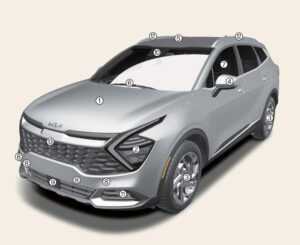
* The actual shape may differ from the illustration.
- Hood
- Headlamp
- Wheel and tire
- Outside rearview mirror
- Panoramic sunroof
- Front windshield wiper blades
- Windows
- Front ultrasonic sensor
- Front radar
- Front view camera
- Front fog lamp
- Roof rack
- SVM-front view camera
Rear view
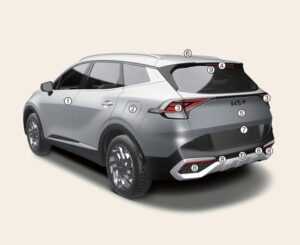
* The actual shape may differ from the illustration.
- Doors
- Fuel filler door
- Rear combination lamp
- High-mounted stop lamp
- Liftgate
- Antenna
- Rearview camera
- Rear ultrasonic sensor
- Rear wiper
- Backup lamp
Interior Overview
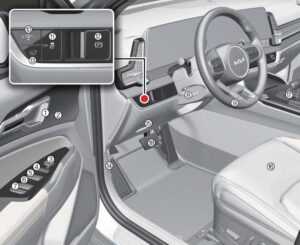
* The actual shape may differ from the illustration.
- Inside door handle
- Seat position memory system
- Outside rearview mirror control switch
- Central door lock/unlock switch
- Power window switches (Front)
- Power window switches (Rear)
- Power window lock button
- Steering wheel tilt/telescopic lever
- Steering wheel
- Interior light adjustment switch
- ESC OFF button
- EPB switch
- Power liftgate open/close button
- Hood release lever
- Instrument panel fuse
- Seat
- Shift lever
- Brake pedal
Instrument panel overview
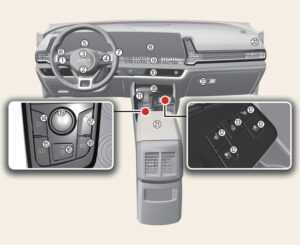
* The actual shape may differ from the illustration.
- Audio remote control button
- Driver’s front airbag
- Horn
- Driving Assist button
- Instrument cluster
- Light control/turn signals lever
- Wiper and washer control lever
- Infotainment system
- Hazard warning flasher switch
- Climate control system
Infotainment/climate switchable controller - ENGINE START/STOP button
- Front seat warmer and air ventilation seat button
- Heated steering wheel button
- Downhill Brake Control(DBC) button
- AUTO HOLD button
- ISG system Off button
- Parking Safety button
- Parking/View button
- Drive mode integrated control system
- The wireless smartphone charging system
- Center console storage box
- Passenger’s front airbag
- Glove box
Engine compartment
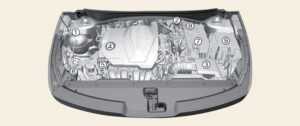
* The actual engine room in the vehicle may differ from the illustration.
- Engine coolant reservoir
- Brake fluid reservoir
- Air cleaner
- Engine oil filler cap
- Engine oil dipstick
- Windshield washer fluid reservoir
- Positive battery terminal
- Negative battery terminal
- Fuse box
FAQ
A: The 2023 Kia Sportage is a compact SUV designed to provide a versatile and stylish transportation solution for individuals and families.
A: The 2023 Sportage typically offers features like advanced safety technology, comfortable seating, ample cargo space, and a range of engine options, including hybrid models.
A: The 2023 Sportage is known for its modern design, robust standard features, and excellent value for its price range.
A: Yes, the 2023 Sportage typically comes in several trim levels, allowing buyers to choose the features and options that best suit their preferences and needs.
A: Yes, AWD is typically available as an option on many trim levels of the 2023 Sportage, providing enhanced traction and stability.
A: The 2023 Sportage may offer various engine choices, including gasoline, hybrid, and plug-in hybrid options, each with its own set of performance and efficiency characteristics.
A: The 2023 Sportage typically seats up to five passengers, with a comfortable and spacious interior cabin.
A: The cargo capacity can vary depending on the trim and whether the rear seats are folded down, but it typically provides ample space for luggage and gear.
A: The 2023 Sportage often comes equipped with a suite of advanced safety features, including adaptive cruise control, lane departure warning, blind-spot monitoring, and automatic emergency braking.
A: The infotainment system typically includes a touchscreen display that allows you to control various functions such as navigation, entertainment, and connectivity with smartphones.
A: Fuel economy can vary depending on the engine and driving conditions, but the 2023 Sportage often offers competitive fuel efficiency, especially in its hybrid and plug-in hybrid versions.
A: Yes, Kia typically offers a comprehensive warranty package for the 2023 Sportage, including a limited warranty, powertrain warranty, and more. Warranty coverage can vary by region and specific terms, so check your owner’s manual or contact a Kia dealership for details.
A: Depending on the trim level, there may be options for upgrading features such as leather upholstery, advanced audio systems, panoramic sunroofs, and more.
A: Yes, Kia typically provides a recommended maintenance schedule in the owner’s manual to help you keep your Sportage running smoothly and ensure longevity.
A: The process of connecting your smartphone usually involves using Bluetooth or USB connections, and the specific steps can be found in the vehicle’s user manual or through on-screen prompts in the infotainment system.
What kind of gas does a 2023 Kia Sportage take?
The 2023 Kia Sportage typically takes regular unleaded gasoline with an octane rating of 87. Always consult your owner’s manual or the gas cap for specific fuel requirements for your vehicle.
What type of fuel does the 2023 Kia Sportage use?
kia sportage 2023 fuel type primarily uses gasoline. It typically runs on regular unleaded gasoline with an octane rating of 87, but it’s essential to consult the owner’s manual or the fuel door for the specific fuel requirements of your vehicle.
Useful Link
View Full User Guide: Kia Sportage 2023 User Guide
Download Manuals: https://owners.kia.com/content/owners/en/manuals.html
2023 KIA SPORTAGE Specs, Price, Mileage, Features and Torque

